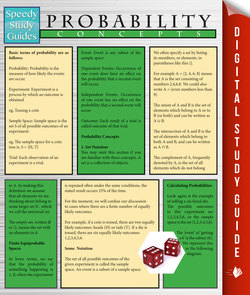Читать книгу Probability Concepts (Speedy Study Guides) - Speedy Publishing - Страница 2
ОглавлениеBasic terms of probability are as follows:
Probability: Probability is the measure of how likely the events are occur.
Experiment: Experiment is a process by which an outcome is obtained
eg, Tossing a coin
Sample Space: Sample space is the set S of all possible outcomes of an experiment.
eg, The sample space for a coin toss is, S = {H, T}
Trial: Each observation of an experiment is a trial.
Event: Event is any subset of the sample space.
Dependent Events: Occurrence of one event does have an effect on the probability that a second event will occur.
Independent Events: Occurrence of one event has no effect on the probability that a second event will occur
Outcome: Each result of a trial is called outcome of that trial.
Probability Concepts
1. Set Notation
You may omit this section if you are familiar with these concepts. A set is a collection of objects.
We often specify a set by listing its members, or elements, in parentheses like this {}.
For example A = {2, 4, 6, 8} means that A is the set consisting of numbers 2,4,6,8. We could also write A = {even numbers less than 9}.
The union of A and B is the set of elements which belong to A or to B (or both) and can be written as A B.
The intersection of A and B is the set of elements which belong to both A and B, and can be written as A B.
The complement of A, frequently denoted by A, is the set of all elements which do not belong
to A. In making this definition we assume that all elements we are thinking about belong to some larger set U, which we call the universal set.
The empty set, written Ø or {}, means the set with no elements in it.
Finite Equiprobable Spaces
In loose terms, we say that the probability of something happening is 1, if, when the experiment
is repeated often under the same conditions, the stated result occurs 25% of the time.
For the moment, we will confine our discussion to cases where there are a finite number of equally likely outcomes.
For example, if a coin is tossed, there are two equally likely outcomes: heads (H) or tails (T). If a die is tossed, there are six equally likely outcomes: 1,2,3,4,5,6.
Some Notation
The set of all possible outcomes of the given experiment is called the sample space. An event is a subset of a sample space.
Calculating Probabilities
Look again at the example of rolling a six faced die. He possible outcomes in this experiment are 1,2,3,4,5,6, so the sample space is the set {1,2,3,4,5,6}.
The ‘event’ of ‘getting
a 6’ is the subset {6}.
We represent this
in the following
diagram.
